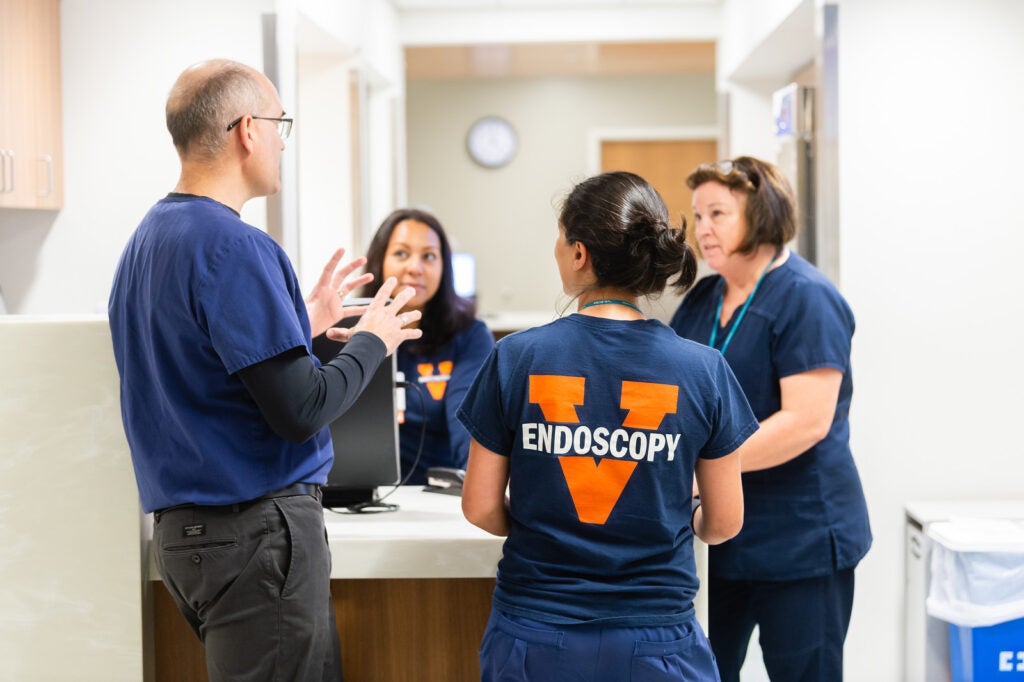Interventional GI
What is Interventional GI?
 UVA Interventional Endoscopy in the Division of Gastroenterology and Hepatology is staffed by physicians Bryan Sauer, Vanessa Shami, Daniel Strand, Ross Buerlein, Alexander Podboy, and Andrew Wang. Together, they offer experienced consultative care for patients with luminal, pancreaticobiliary, and oncologic disorders of the gastrointestinal (GI) tract.
UVA Interventional Endoscopy in the Division of Gastroenterology and Hepatology is staffed by physicians Bryan Sauer, Vanessa Shami, Daniel Strand, Ross Buerlein, Alexander Podboy, and Andrew Wang. Together, they offer experienced consultative care for patients with luminal, pancreaticobiliary, and oncologic disorders of the gastrointestinal (GI) tract.
UVA Interventional Endoscopy utilizes innovative and specialized endoscopic procedures to achieve its goal of providing advanced patient care of the highest quality. For some of these advanced procedures, patients are referred to us from the mid-Atlantic region and across the country.
UVA Interventional Endoscopy, in collaboration with other faculty members in the Division of Gastroenterology and Hepatology, offers the following:
Diagnostic Endoscopy
Diagnostic endoscopies are performed to visualize the GI tract to diagnose abnormal conditions. If abnormal conditions are discovered, they may be treated medically, surgically, or endoscopically.
In a diagnostic GI endoscopy, physicians use endoscopes — sophisticated instruments with a thin, flexible tube equipped with a tiny camera and light — to see inside the GI tract. The endoscope is inserted through the mouth or rectum. A biopsy may be performed to collect a tissue sample when abnormalities such as polyps, ulcers, or strictures are found. The results will then guide medical treatment. When precancerous polyps are found, the diagnostic endoscopy may then be followed by a therapeutic endoscopy, during which the polyp is removed to reduce the risk of cancer developing in the digestive tract in the future.
Interventional Endoscopy
In addition to diagnostic procedures, UVA Interventional Endoscopy offers advanced endoscopic procedures, such as:
- Advanced polypectomy, including:
- Endoscopic Mucosal Resection (EMR)
- Endoscopic Submucosal Dissection (ESD)
- Peroral Endoscopy Myotomy (POEM), including:
- Esophageal POEM
- Gastric POEM
- Zenker’s POEM
- Endoscopic Retrograde Cholangiopancreatography (ERCP), including with:
- Lithotripsy (mechanical, laser, electrohydraulic/EHL)
- Endobiliary Ablation
- Radiofrequency Ablation
- Photodynamic Therapy
- Plastic and metal stenting
- Cholangioscopy
- Endoscopic Ultrasound-directed Transgastric ERCP (EDGE)
- Endobariatrics, including:
- Endoscopic sleeve gastroplasty (ESG) and Endoscopic revision of previous sleeve gastrectomy (revisional ESG)
- Endoscopic balloon placement for weight loss
- Endoscopic revision of gastric bypass (TORe)
- Gastric Tunneled Stricturotomy for the treatment of refractory surgical sleeve stenosis
- Endoscopic management of roux en y gastric bypass candy cane syndrome
- Endoscopic reversal of roux en y gastric bypass (GATE)
- Endoscopic suturing for management of bariatric surgical leaks
- Endoscopic Ultrasound (EUS), including:
- EUS-directed fine needle injection of chemotherapy for pancreatic cyst ablation
- EUS-directed liver biopsy
- EUS-directed portal pressure measurements
- EUS-directed biliary access
- Endoscopic necrosectomy and cyst gastrostomy
- Single Balloon Enteroscopy
- Antegrade
- Retrograde
- ERCP
Information about our program
 The University of Virginia (UVA) Advanced Endoscopy Fellowship program offers qualified applicants exposure to various interventional endoscopy techniques and outstanding clinical endoscopic and GI training. We routinely perform over 1,000 ERCP and 800 EUS procedures each year. We perform therapeutic ERCP, which includes choledochoscopy, laser lithotripsy, PDT, RFA, and enteroscopy-assisted ERCP. In addition to diagnostic EUS and EUS/FNA, we perform interventional EUS, which includes celiac plexus block/neurolysis, cystgastrostomy, cystduodenostomy, pancreatic necrosectomy, and EUS-guided ERCP. As an NPF Pancreatitis Center, we offer exposure to pancreatic function testing and ESWL. Lastly, we have particular interest and expertise in advanced optical imaging (NBI, chromoendoscopy, and confocal endomicroscopy), esophageal RFA and cryotherapy, conventional and underwater EMR, ESD, and POEM procedures.
The University of Virginia (UVA) Advanced Endoscopy Fellowship program offers qualified applicants exposure to various interventional endoscopy techniques and outstanding clinical endoscopic and GI training. We routinely perform over 1,000 ERCP and 800 EUS procedures each year. We perform therapeutic ERCP, which includes choledochoscopy, laser lithotripsy, PDT, RFA, and enteroscopy-assisted ERCP. In addition to diagnostic EUS and EUS/FNA, we perform interventional EUS, which includes celiac plexus block/neurolysis, cystgastrostomy, cystduodenostomy, pancreatic necrosectomy, and EUS-guided ERCP. As an NPF Pancreatitis Center, we offer exposure to pancreatic function testing and ESWL. Lastly, we have particular interest and expertise in advanced optical imaging (NBI, chromoendoscopy, and confocal endomicroscopy), esophageal RFA and cryotherapy, conventional and underwater EMR, ESD, and POEM procedures.
Our Section of Interventional Endoscopy, which includes Drs. Vanessa Shami, Andrew Wang, Bryan Sauer, Daniel Strand, Ross Buerlein, and Alexander Podboy is nationally and internationally recognized for their clinical expertise and interest in endoscopic education. Our program has a tradition of training outstanding advanced endoscopy fellows who have become leaders in clinical practice and academic medicine.
Requirements for Application
- Standard ASGE Application Packet
- ASGE Application
- Post-Undergraduate Education
- USMLE Scores (if necessary)
- Certification of Completion of Residency
- Before appointment in the advanced endoscopy fellowship, fellows should have completed a three-year ACGME-accredited gastroenterology fellowship
- Fellows from non-ACGME-accredited programs must have completed at least three years of gastroenterology education before starting the fellowship
- Personal Statement
- Curriculum Vitae
- 3 Letters of Reference
- Additional Requirements from the Program
- U.S. citizenship or permanent residency (at the time of submitting this application)
- Completed training in an ACGME-accredited internal medicine residency program
- Enrolled in or completed training in an ACGME-accredited gastroenterology and hepatology fellowship program
- Applicants who are GI fellows at the time of application must have board certification in Internal Medicine by the ABIM
- Applicants who have completed GI fellowship training and have been in GI practice (for six months) must have board certification in Gastroenterology by the ABIM
Medical Directors
Section Chief & Director of Interventional Endoscopy
Co-Director of Advanced Endoscopy Fellowship Program
Administrative Assistant:
Tammy Eubank 434.297.7206
Director of Endoscopic Ultrasound
Administrative Assistant:
Tammy Eubank 434.297.7206
Director of Pancreatobiliary Endoscopy
Director of NPF Pancreatitis Center of Excellence
Co-Director of Advanced Endoscopy Fellowship Program
Administrative Assistant:
Joanne Delapp-Anderson 434.297.7207
Medical Teams
Dawn Cox, RN, CGRN 434.982.3132
Beth Woodward, RN 434.243.6310
Terri Rodee, BSN 434.243.6369
Brenda Vaughn, BSN 434.243.2521
Marci Williams, RN 434.982.0233
Michelle Schmidt, RN 434.982.3512
